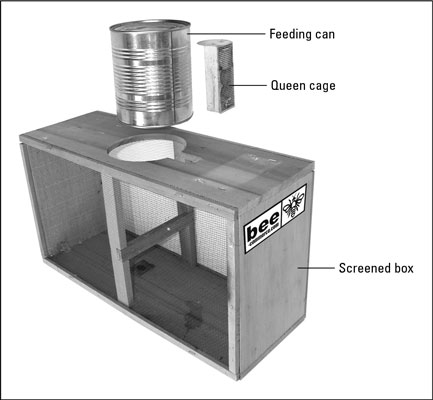Get ready to place your orders! I've seen quite a few pricing and availability announcements for 2013. Hopefully you've spent the last month or two learning about the honeybee life cycle and behavior. If not, just stop reading right now and buy a book. The one, I mean THE one, to buy right now for Top Bar Beekeepers, is Wyatt Mangum's "200 Top-Bar Hives: The Low-Cost Sustainable Way." While you're waiting for your book to arrive, today's posts are real-world rundowns on various ways of getting bees.
Package Bees
What You're Sold: ±3 pounds of bees, race of your choosing. You can buy Russian or Minnesota Hygienic (varroa sensitive), Carniolan (gentle), Italian (honey producers), etc. Price: a 3# pkg should cost about $100 ±$20. Be sure to have your hives ready and waiting by mid- to late-April.
 |
| http://www.dummies.com/how-to/content/how-to-obtain-your-initial-bee-colony.html |
Why You Should Want One: you get to pick the race of your queen. Since the "colony" is broodless and combless, you have less concern about brood diseases like AFB. As with a swarm, the bees have lots of work to do, yet are dying off for the first 3 weeks. The work pace is well suited to beginning beekeepers.
When to Order One: Start shopping in November. Good producers are often sold out by February even though delivery won't happen until April.
How to Get One: beekeeping clubs often buy in bulk (i.e.: better prices). Some are listed on the Colorado State Beekeepers Association web site.
Problems with Packages: Apparently nurse bees cling to combs really well, so the bees that get funneled in are mostly flying bees (i.e.: the older, going-to-die-sooner bees). The worker bees' race is not what you have chosen; it is whatever the bee breeder has plenty of, from however many hives it takes to make 3#. They don't necessarily like each other but they're too freaked out to fight. (It's somewhat irrelevant, as what matters is the breed of the queen. Ultimately, she is what you paid for.) Of significance is that the queen is not the mother to any of these bees and they want to kill her. The sugar water isn't much to live on and a road trip is very stressful. When the bees are finally in your possession, they get banged around, sprayed/smoked/sugar-dusted, and dumped again into a hive where everything again is new and strange. No wonder the queen you so thoughtfully selected gets superceded. It doesn't always happen, but often enough. They smartly wait until the initial die-off is passed and there are replacement workers on the way, but watch for supercedure cells pretty early on. (With new comb in a TBH, the bees are able to build them on the comb edges so don't assume they are preparing to swarm if you see them there. Packages are more likely to abscond than swarm.) The replacement queen they raise will have the paid-for genetics, but the drones she mates with will be who-knows-what. The colony she heads will be half the race you paid for, and half local (possibly Africanized if you live in the South). We would never start from a package again, unless it were free, preferably from a producer that does not participate in almond pollination.
Migratory beekeeping, a practice which exponentially increases interaction between healthy and infested colonies, is the primary source of package bees. Do not let anyone tell you that package bees don't introduce varroa mites into your hive as quite the opposite is true. With delayed treatment application, package bees can be heavily infested.
Write this one down, new #beekeepers: Trick for Installing Packages bit.ly/VUgaac #beekeeping
— HB (@Hello_Kitty_) January 17, 2013

0 comments:
Post a Comment
Join the Conversation. Leave a comment.